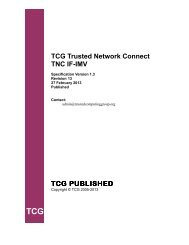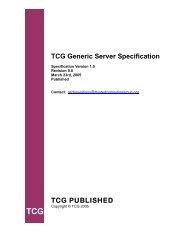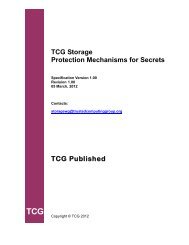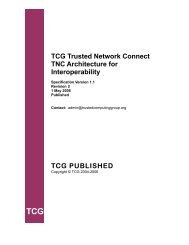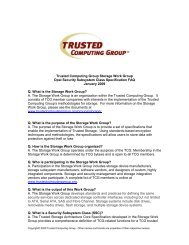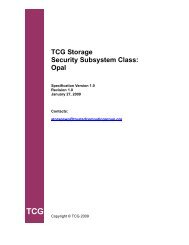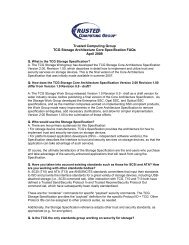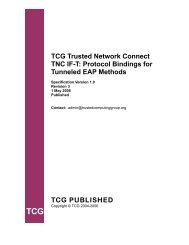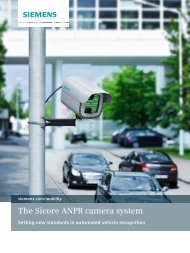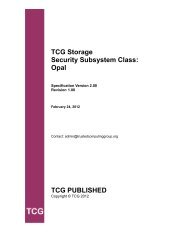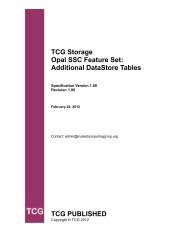TCG Storage Interface Interactions Specification(SIIS)
TCG Storage Interface Interactions Specification(SIIS)
TCG Storage Interface Interactions Specification(SIIS)
Create successful ePaper yourself
Turn your PDF publications into a flip-book with our unique Google optimized e-Paper software.
<strong>TCG</strong><br />
<strong>TCG</strong> <strong>Storage</strong> <strong>Interface</strong> <strong>Interactions</strong><br />
<strong>Specification</strong> (<strong>SIIS</strong>)<br />
<strong>Specification</strong> Version 1.02<br />
Revision 1.00<br />
30 December, 2011<br />
<strong>TCG</strong> PUBLISHED<br />
Copyright © <strong>TCG</strong> 2011
<strong>Storage</strong> <strong>Interface</strong> <strong>Interactions</strong> <strong>Specification</strong> <strong>TCG</strong> Copyright 2011<br />
<strong>Specification</strong> Version 1.02 Revision 1.00<br />
Copyright © 2011 Trusted Computing Group, Incorporated.<br />
Disclaimers, Notices, and License Terms<br />
THIS SPECIFICATION IS PROVIDED "AS IS" WITH NO WARRANTIES WHATSOEVER,<br />
INCLUDING<br />
ANY WARRANTY OF MERCHANTABILITY, NONINFRINGEMENT, FITNESS FOR ANY PARTICULAR<br />
PURPOSE, OR ANY WARRANTY OTHERWISE ARISING OUT OF ANY PROPOSAL, SPECIFICATION<br />
OR SAMPLE.<br />
Without limitation, <strong>TCG</strong> disclaims all liability, including liability for<br />
infringement of any proprietary rights,<br />
relating to use of information in this specification and to the<br />
implementation of this specification, and <strong>TCG</strong><br />
disclaims all liability for cost of procurement of substitute goods or<br />
services, lost profits, loss of use, loss<br />
of data or any incidental, consequential, direct, indirect, or special<br />
damages, whether under contract, tort,<br />
warranty or otherwise, arising in any way out of use or reliance upon this<br />
specification or any information<br />
herein.<br />
This document is copyrighted by Trusted Computing Group (<strong>TCG</strong>), and no license, express or<br />
implied, is granted herein other than as follows: You may not copy or reproduce the document<br />
or distribute it to others without written permission from <strong>TCG</strong>, except that you may freely do so<br />
for the purposes of (a) examining or implementing <strong>TCG</strong> specifications or (b) developing, testing,<br />
or promoting information technology standards and best practices, so long as you distribute<br />
the document with these disclaimers, notices, and license terms.<br />
Contact the Trusted Computing Group at www.trustedcomputinggroup.org for<br />
information on specification<br />
licensing through membership agreements.<br />
Any marks and brands contained herein are the property of their respective<br />
owners.<br />
Page ii of 24
<strong>Storage</strong> <strong>Interface</strong> <strong>Interactions</strong> <strong>Specification</strong> <strong>TCG</strong> Copyright 2011<br />
<strong>Specification</strong> Version 1.02 Revision 1.00<br />
Change History<br />
Version Date Description<br />
Version 1.00<br />
Rev 1.00<br />
27 Jan 2009 First publication<br />
Version 1.01<br />
Revision 1.00<br />
03 Nov 2011 for all interfaces:<br />
a) added specification of Current Maximum LBA<br />
Version 1.02<br />
Revision 1.00<br />
b) clarified the specification of behavior when Transfer Length<br />
is zero<br />
for the SCSI interface<br />
a) added mapping of USB and UAS resets<br />
b) clarified the use of INC_512<br />
c) Tables 4 and 5: indicated which standard or specification<br />
defines the event, and removed the false indication that all<br />
of the events were 'resets'<br />
d) SCSI: Table 7: changed TRANSFER LENGTH to<br />
ALLOCATION LENGTH and noted that the non-zero length<br />
requirement is a variance from the definition of the<br />
command in SPC-4<br />
for the ATA interface:<br />
a) changed the base ATA reference from ATA8-ACS to ACS-2<br />
b) clarified the Locking Template interactions with the ATA<br />
Security feature set to include Locking SP activation and<br />
revert functions<br />
c) clarified the use of the ATA Sense Data Reporting feature<br />
set in ATA error reporting<br />
d) added specification of interaction of the ATA Sanitize<br />
Device feature set with the Locking SP<br />
e) Addressed comments received during public review<br />
30 Dec 2011 Added NVM Express support<br />
Page iii of 24
<strong>Storage</strong> <strong>Interface</strong> <strong>Interactions</strong> <strong>Specification</strong> <strong>TCG</strong> Copyright 2011<br />
<strong>Specification</strong> Version 1.02 Revision 1.00<br />
Table of Contents<br />
1 Introduction ............................................................................................................ 5<br />
1.1 Document Purpose .......................................................................................................................... 5<br />
1.2 Scope ............................................................................................................................................... 5<br />
1.3 Intended Audience ........................................................................................................................... 5<br />
1.4 References to Other Documents ..................................................................................................... 5<br />
1.5 Definition of Terms ........................................................................................................................... 6<br />
2 Overview ................................................................................................................. 6<br />
3 SCSI <strong>Interface</strong> ......................................................................................................... 7<br />
3.1 Mapping of Resets ........................................................................................................................... 7<br />
3.2 Mapping of IF-SEND and IF-RECV ............................................................................................... 11<br />
3.2.1 IF_SEND ............................................................................................................................... 11<br />
3.2.2 IF_RECV ............................................................................................................................... 11<br />
3.3 Handling Common TPer Errors ...................................................................................................... 12<br />
3.4 Discovery of Security Capabilities .................................................................................................. 13<br />
3.4.1 Security Protocol 0x00 .......................................................................................................... 13<br />
3.5 Miscellaneous Issues ..................................................................................................................... 13<br />
3.5.1 Queued Commands .............................................................................................................. 13<br />
3.5.2 MBR <strong>Interactions</strong> ................................................................................................................... 14<br />
3.5.3 LUN usage ............................................................................................................................. 14<br />
3.5.4 Current Maximum LBA .......................................................................................................... 15<br />
4 ATA <strong>Interface</strong> ........................................................................................................ 16<br />
4.1 Mapping of Resets ......................................................................................................................... 16<br />
4.2 Mapping of IF-SEND and IF-RECV ............................................................................................... 17<br />
4.2.1 IF_SEND ............................................................................................................................... 17<br />
4.2.2 IF_RECV ............................................................................................................................... 17<br />
4.3 Handling Common TPer Errors ...................................................................................................... 18<br />
4.4 Discovery of Security Capabilities .................................................................................................. 19<br />
4.4.1 IDENTIFY DEVICE ................................................................................................................ 19<br />
4.4.2 Security Protocol 0x00 .......................................................................................................... 19<br />
4.5 Miscellaneous Issues ..................................................................................................................... 19<br />
4.5.1 Feature set interactions ......................................................................................................... 19<br />
4.5.2 Current Maximum LBA .......................................................................................................... 20<br />
5 NVM Express <strong>Interface</strong> ........................................................................................ 21<br />
5.1 Mapping of Resets ......................................................................................................................... 21<br />
5.2 Mapping of IF-SEND and IF-RECV ............................................................................................... 22<br />
5.2.1 IF_SEND ............................................................................................................................... 22<br />
5.2.2 IF_RECV ............................................................................................................................... 22<br />
5.3 Handling Common TPer Errors ...................................................................................................... 23<br />
5.4 Discovery of Security Capabilities .................................................................................................. 23<br />
5.4.1 Identify Controller Data Structure .......................................................................................... 23<br />
5.4.2 Security Protocol 0x00 .......................................................................................................... 23<br />
5.5 Miscellaneous Issues ..................................................................................................................... 23<br />
5.5.1 Security Commands .............................................................................................................. 23<br />
5.5.2 Namespace ........................................................................................................................... 23<br />
5.5.3 Locking Template interactions with the Format NVM Command .......................................... 24<br />
Page iv of 24
<strong>Storage</strong> <strong>Interface</strong> <strong>Interactions</strong> <strong>Specification</strong> <strong>TCG</strong> Copyright 2011<br />
<strong>Specification</strong> Version 1.02 Revision 1.00<br />
1 Introduction<br />
1.1 Document Purpose<br />
The <strong>TCG</strong> <strong>Storage</strong> specifications are intended to provide a comprehensive command architecture for<br />
putting storage devices under policy control as determined by the trusted platform host, the capabilities<br />
of the storage device to conform with the policies of the trusted platform, and the lifecycle state of the<br />
storage device as a trusted peripheral (TPer). This document MAY also serve as a specification for<br />
TPers if that is deemed appropriate.<br />
This document provides the essential mapping between concepts and features of the <strong>TCG</strong> <strong>Storage</strong><br />
Architecture Core <strong>Specification</strong>, and several host/device interfaces.<br />
1.2 Scope<br />
The scope of this document is the interaction between the TPer and interface commands and<br />
transports. The command interfaces described are ATA and SCSI. SCSI transports described are SAS,<br />
FC, and ATAPI. This document is written from the perspective of the storage device, not the host.<br />
1.3 Intended Audience<br />
The intended audience for this document is storage device and peripheral device manufacturers and<br />
developers that MAY wish to tie storage devices and peripherals into trusted platforms.<br />
1.4 References to Other Documents<br />
[1]. IETF RFC 2119, 1997, “Key words for use in RFCs to Indicate Requirement Levels”<br />
[2]. [INCITS T10/1683-D], "Information technology - SCSI Architecture Model - 4 (SAM-4)"<br />
[3]. [INCITS T10/1731-D], "Information technology - SCSI Primary Commands - 4 (SPC-4)"<br />
[4]. [INCITS T10/1799-D], "Information technology - SCSI Block Commands - 3 (SBC-3)"<br />
[5]. [INCITS T13/2015-D], "Information technology - ATA/ATAPI Command Set - 2 (ACS-2)"<br />
[6]. [INCITS T13/1700-D], "Information technology - AT Attachment – 8 ATA/ATAPI Architecture<br />
Model (ATA8-AAM)"<br />
[7]. [INCITS T10/1828-D], "Information technology - Fibre Channel Protocol for SCSI, Fourth Version<br />
(FCP-4)"<br />
[8]. [ANSI INCITS 417-2006], "Information technology - Serial Attached SCSI - 1.1 (SAS-1.1)<br />
[9]. Information technology - USB Attached SCSI (UAS), T10/2095-D Revision 4, March 9, 2010<br />
[10]. Universal Serial Bus Mass <strong>Storage</strong> Class USB Attached SCSI Protocol (UASP), Revision 1.0,<br />
June 24, 2009<br />
[11]. Universal Serial Bus Mass <strong>Storage</strong> Class Bulk-Only Transport (USBBOT), Revision 1.0,<br />
September 31, 1999<br />
[12]. NVM Express <strong>Specification</strong> version 1.0. Available from http://www.nvmexpress.org/<br />
Page 5 of 24
<strong>Storage</strong> <strong>Interface</strong> <strong>Interactions</strong> <strong>Specification</strong> <strong>TCG</strong> Copyright 2011<br />
<strong>Specification</strong> Version 1.02 Revision 1.00<br />
1.5 Definition of Terms<br />
.<br />
Term Definition<br />
IF-RECV An interface command used to retrieve security protocol data from<br />
the TPer.<br />
IF-SEND An interface command used to transmit security protocol data to the<br />
TPer.<br />
Locking SP A security provider that incorporates the Locking Template as<br />
described in the Core Spec.<br />
SSC Security Subsystem Class. SSC specifications describe profiled sets<br />
of <strong>TCG</strong> functionality<br />
<strong>TCG</strong> Reset A high-level reset type defined in the Core Spec.<br />
TPer The <strong>TCG</strong> security subsystem within a storage device.<br />
Trusted Peripheral A TPer.<br />
2 Overview<br />
This document defines for each interface:<br />
� Mapping of interface events to <strong>TCG</strong> resets<br />
� Mapping of IF-SEND, IF-RECV<br />
� Handling of common TPer errors<br />
� Discovery of security capabilities<br />
� Miscellaneous issues<br />
Page 6 of 24
<strong>Storage</strong> <strong>Interface</strong> <strong>Interactions</strong> <strong>Specification</strong> <strong>TCG</strong> Copyright 2011<br />
<strong>Specification</strong> Version 1.02 Revision 1.00<br />
3 SCSI <strong>Interface</strong><br />
See [2], [3], [4], [7] and [8] for details on SCSI architecture, commands and transports.<br />
See [5] for details on ATAPI commands.<br />
See [9], [10] and [11] for details on UAS and USB.<br />
3.1 Mapping of Resets<br />
Table 1 - SAS Resets Mapped to <strong>TCG</strong> reset_type<br />
SAS Event<br />
Maps to <strong>TCG</strong><br />
reset_type<br />
Power on reset Power cycle<br />
I-T Nexus Loss (none)<br />
Task Management-Abort Task (none)<br />
Task Management-Abort Task Set (none)<br />
Task Management-Clear Task Set (none)<br />
Task Management-Clear ACA (none)<br />
Task Management-I-T Nexus reset (none)<br />
Task Management-LUN Reset Hardware Reset<br />
Link Reset Sequence (none)<br />
Link reset sequence with hard reset Hardware Reset<br />
Table 2 - Fibre Channel Resets Mapped to <strong>TCG</strong> reset_type<br />
FC Event<br />
Maps to <strong>TCG</strong><br />
reset_type Other Comments<br />
Power on reset Power cycle<br />
I-T Nexus Loss (none)<br />
Task Management-Abort Task (none)<br />
Task Management-Abort Task Set (none)<br />
Task Management-Clear Task Set (none)<br />
Task Management-Clear ACA (none)<br />
Task Management-I-T Nexus reset (none)<br />
Task Management-LUN Reset Hardware Reset<br />
Task Management-Target reset Hardware Reset<br />
LIP(AL_PD,AL_PS) Hardware Reset LIP directed reset<br />
LIP(FF,AL_PS) Hardware Reset LIP Global reset<br />
Port Login (none)<br />
Process Login (none)<br />
Page 7 of 24
<strong>Storage</strong> <strong>Interface</strong> <strong>Interactions</strong> <strong>Specification</strong> <strong>TCG</strong> Copyright 2011<br />
<strong>Specification</strong> Version 1.02 Revision 1.00<br />
Table 3 - ATAPI Resets Mapped to <strong>TCG</strong> reset_type<br />
ATAPI Event Maps to <strong>TCG</strong> reset_type<br />
Power on reset Power cycle<br />
Hardware reset PATA:<br />
Hardware Reset<br />
Software reset (none)<br />
DEVICE RESET command (none)<br />
SATA:<br />
If Software Settings Preservation is enabled,<br />
then COMRESET is not a <strong>TCG</strong> Hardware<br />
Reset.<br />
If Software Settings Preservation is disabled,<br />
then COMRESET is a <strong>TCG</strong> Hardware Reset.<br />
Page 8 of 24
<strong>Storage</strong> <strong>Interface</strong> <strong>Interactions</strong> <strong>Specification</strong> <strong>TCG</strong> Copyright 2011<br />
<strong>Specification</strong> Version 1.02 Revision 1.00<br />
Event<br />
Device Power Cycle<br />
Task Management-Abort Task<br />
Task Management-Abort Task Set<br />
Task Management-Clear Task Set<br />
Task Management-Clear ACA<br />
Task Management-I-T Nexus reset<br />
Task Management-LUN Reset<br />
USB VBus Power Cycle<br />
USB Port Reset<br />
USB Set Configuration with wValue set to zero<br />
Table 4 - UAS Events Mapped to <strong>TCG</strong> reset_type<br />
USB Set Configuration with wValue set to non-zero value that<br />
is not equal to the current value of bConfiguration.<br />
USB Set Configuration with wValue set to non-zero value that<br />
is equal to the current value of bConfiguration.<br />
USB Bulk-Out Endpoint Reset (Also known as Clear Feature,<br />
Endpoint Halt of the first Bulk-Out pipe of the Mass <strong>Storage</strong><br />
<strong>Interface</strong>)<br />
USB Bulk-In Endpoint Reset (Also known as Clear Feature,<br />
Endpoint Halt of the first Bulk-In pipe of the Mass <strong>Storage</strong><br />
<strong>Interface</strong>)<br />
USB Suspend<br />
USB Resume<br />
Maps to <strong>TCG</strong><br />
reset_type<br />
Reference<br />
Power cycle [11]<br />
(none) [3]<br />
(none) [3]<br />
(none) [3]<br />
(none) [3]<br />
Hardware Reset [3]<br />
(none) [3]<br />
Power cycle [11]<br />
(none) [11]<br />
(none) [11]<br />
(none) [11]<br />
(none) [11]<br />
(none) [11]<br />
(none) [11]<br />
Hardware Reset [11]<br />
Hardware Reset [11]<br />
Page 9 of 24
<strong>Storage</strong> <strong>Interface</strong> <strong>Interactions</strong> <strong>Specification</strong> <strong>TCG</strong> Copyright 2011<br />
<strong>Specification</strong> Version 1.02 Revision 1.00<br />
Event<br />
Device Power Cycle<br />
USB VBus Power Cycle<br />
USB Port Reset<br />
USB Set Configuration with wValue set to zero<br />
Table 5 - USB Events Mapped to <strong>TCG</strong> reset_type<br />
USB Set Configuration with wValue set to non-zero value that is<br />
not equal to the current value of bConfiguration.<br />
USB Set Configuration with wValue set to non-zero value that is<br />
equal to the current value of bConfiguration.<br />
USB Bulk-Out Endpoint Reset (Also known as Clear Feature,<br />
Endpoint Halt of the first Bulk-Out pipe of the Mass <strong>Storage</strong><br />
<strong>Interface</strong>)<br />
USB Bulk-In Endpoint Reset (Also known as Clear Feature,<br />
Endpoint Halt of the first Bulk-In pipe of the Mass <strong>Storage</strong><br />
<strong>Interface</strong>)<br />
USB <strong>Interface</strong> Reset (Also known as the BBB Bulk Only Mass<br />
<strong>Storage</strong> Reset Request x 21 FF with wIndex addressing the<br />
b<strong>Interface</strong>Number of the Mass <strong>Storage</strong> <strong>Interface</strong>)<br />
USB Suspend<br />
USB Resume<br />
Maps to <strong>TCG</strong><br />
reset_type Reference<br />
Power cycle [11]<br />
Power cycle [11]<br />
(none) [11]<br />
(none) [11]<br />
(none) [11]<br />
(none) [11]<br />
(none) [11]<br />
(none) [11]<br />
(none) [11]<br />
Hardware Reset [11]<br />
Hardware Reset [11]<br />
Page 10 of 24
<strong>Storage</strong> <strong>Interface</strong> <strong>Interactions</strong> <strong>Specification</strong> <strong>TCG</strong> Copyright 2011<br />
<strong>Specification</strong> Version 1.02 Revision 1.00<br />
3.2 Mapping of IF-SEND and IF-RECV<br />
3.2.1 IF_SEND<br />
IF_SEND SHALL be implemented with the SECURITY PROTOCOL OUT [3] command, with additional<br />
requirements on the CDB as specified in Table 6.<br />
Table 6 - IF-SEND CDB field contents (SCSI)<br />
SECURITY<br />
PROTOCOL SECURITY PROTOCOL SPECIFIC INC_512 TRANSFER LENGTH<br />
0x00 Security protocol 0x00 is not defined for IF-SEND<br />
0x01 a ComID 1 a<br />
0x02 a ComID 1 a<br />
Non-zero b number of 512byte<br />
data units.<br />
Non-zero b number of 512byte<br />
data units.<br />
0x06 a ComID 0 Number of bytes of data.<br />
a If the INC_512 parameter in the CDB is zero, then the TPer SHALL report Other Invalid<br />
Command Parameter (see 3.3).<br />
b If the TRANSFER LENGTH parameter in the CDB is zero, then the TPer SHALL report Other Invalid<br />
Command Parameter (see 3.3).<br />
3.2.2 IF_RECV<br />
IF_RECV SHALL be implemented with the SECURITY PROTOCOL IN [3] command, with additional<br />
requirements on the CDB as described in Table 7.<br />
Table 7 - IF-RECV CDB field contents (SCSI)<br />
SECURITY<br />
PROTOCOL SECURITY PROTOCOL SPECIFIC INC_512 ALLOCATION LENGTH<br />
0x00 (See [3] for details) 0 or 1<br />
0x01 a ComID 1 a<br />
0x02 a ComID 1 a<br />
INC_512=0: Number of bytes<br />
of data.<br />
INC_512=1: Number of 512byte<br />
data units.<br />
Non-zero b number of 512byte<br />
data units.<br />
Non-zero b number of 512byte<br />
data units.<br />
0x06 a ComID 0 Number of bytes of data.<br />
a If the INC_512 parameter in the CDB is zero, then the TPer SHALL report Other Invalid<br />
Command Parameter (see 3.3).<br />
b If the ALLOCATION LENGTH parameter in the CDB is zero, then the TPer SHALL report Other<br />
Invalid Command Parameter (see 3.3), even though SPC-4 allows ALLOCATION LENGTH to be<br />
zero.<br />
Page 11 of 24
<strong>Storage</strong> <strong>Interface</strong> <strong>Interactions</strong> <strong>Specification</strong> <strong>TCG</strong> Copyright 2011<br />
<strong>Specification</strong> Version 1.02 Revision 1.00<br />
3.3 Handling Common TPer Errors<br />
There are some common errors detected by the TPer. This section describes how they are reported via<br />
the SCSI interface.<br />
Table 8 - TPer Errors (SCSI)<br />
TPer Error ID Status Sense Key ASC/ASCQ Comments<br />
Good GOOD NO SENSE<br />
Invalid Security<br />
Protocol ID<br />
parameter<br />
Invalid Transfer<br />
Length parameter<br />
on IF-SEND<br />
Other Invalid<br />
Command<br />
Parameter<br />
Synchronous<br />
Protocol Violation<br />
Data Protection<br />
Error<br />
CHECK<br />
CONDITION<br />
CHECK<br />
CONDITION<br />
CHECK<br />
CONDITION<br />
CHECK<br />
CONDITION<br />
CHECK<br />
CONDITION<br />
ILLEGAL<br />
REQUEST<br />
ILLEGAL<br />
REQUEST<br />
ILLEGAL<br />
REQUEST<br />
ILLEGAL<br />
REQUEST<br />
DATA<br />
PROTECT<br />
NO ADDITIONAL<br />
SENSE<br />
INFORMATION<br />
INVALID FIELD IN<br />
CDB<br />
INVALID FIELD IN<br />
CDB<br />
INVALID FIELD IN<br />
CDB<br />
COMMAND<br />
SEQUENCE ERROR<br />
ACCESS DENIED–<br />
NO ACCESS RIGHTS<br />
Normal command<br />
completion<br />
No data shall be<br />
transferred<br />
No data shall be<br />
transferred.<br />
No data shall be<br />
transferred.<br />
No data shall be<br />
transferred.<br />
No data shall be<br />
transferred.<br />
Page 12 of 24
<strong>Storage</strong> <strong>Interface</strong> <strong>Interactions</strong> <strong>Specification</strong> <strong>TCG</strong> Copyright 2011<br />
<strong>Specification</strong> Version 1.02 Revision 1.00<br />
3.4 Discovery of Security Capabilities<br />
3.4.1 Security Protocol 0x00<br />
See the description of SECURITY PROTOCOL IN [3] for information on Security Protocol 0x00.<br />
3.5 Miscellaneous Issues<br />
3.5.1 Queued Commands<br />
The TPer requires that for a given ComID the order of the IF-SEND and IF-RECV command<br />
completion be the same as the order that the host application sent the commands.<br />
Some transport protocols MAY NOT guarantee ordering of delivery or ordering of IF-SEND and<br />
IF-RECV command completion. Therefore, the host application communicating with the TPer<br />
should ensure that a prior IF-SEND or IF-RECV has completed prior to issuing another, or use<br />
mechanisms in the interface protocol to ensure ordering (e.g. ORDERED Task Attribute for<br />
SCSI Transport protocols).<br />
Begin Informative Content<br />
The following definition of synchronous behavior does not affect the queuing behavior (if any) of the<br />
device interface. On queuing devices, synchronicity is enforced at the time IF-SEND/RECV commands<br />
are dequeued for processing by the drive. For non-queuing devices, synchronicity is enforced at the<br />
time the IF-SEND/RECV is initially received by the device. If queuing behavior is supported, the host<br />
should use Ordered Queuing for IF-SEND/RECV commands or indeterminate behavior may result.<br />
It is assumed that the drive can only process one IF-SEND/RECV interface command at a time.<br />
End Informative Content<br />
Page 13 of 24
<strong>Storage</strong> <strong>Interface</strong> <strong>Interactions</strong> <strong>Specification</strong> <strong>TCG</strong> Copyright 2011<br />
<strong>Specification</strong> Version 1.02 Revision 1.00<br />
3.5.2 MBR <strong>Interactions</strong><br />
The LUN associated with the MBR is the boot LUN.<br />
3.5.3 LUN usage<br />
A target that has multiple LUNs MAY have multiple TPers. Each TPer SHALL be associated with a<br />
different LUN. Every LUN on a device is not required to have a TPer, but LUNs that support the <strong>TCG</strong><br />
Core specification commands and functionality SHALL have a TPer. A TPer SHALL only be associated<br />
with exactly one LUN. A LUN MAY have no TPer.<br />
port A port B<br />
LUN 0 LUN 1 LUN N<br />
TPer<br />
Figure 1 - SCSI target: port, LUN and TPer relationships<br />
TPer<br />
Page 14 of 24
<strong>Storage</strong> <strong>Interface</strong> <strong>Interactions</strong> <strong>Specification</strong> <strong>TCG</strong> Copyright 2011<br />
<strong>Specification</strong> Version 1.02 Revision 1.00<br />
3.5.4 Current Maximum LBA<br />
The Current Maximum LBA is the maximum LBA that is permitted at the current time by a normal read<br />
or write command.<br />
Table 9 specifies the definition of Current Maximum LBA. Current Maximum LBA is undefined if it is<br />
not specified in Table 9.<br />
Table 9 - Current Maximum LBA (SCSI)<br />
READ<br />
CAPACITY(10) 1 READ CAPACITY(16) 1 Current Maximum LBA<br />
RETURNED LOGICAL CDB not supported READ CAPACITY(10)<br />
BLOCK ADDRESS<br />
RETURNED LOGICAL BLOCK ADDRESS<br />
< FFFF_FFFFh<br />
parameter<br />
RETURNED LOGICAL CDB supported and<br />
READ CAPACITY(16)<br />
BLOCK ADDRESS RETURNED LOGICAL BLOCK ADDRESS RETURNED LOGICAL BLOCK ADDRESS<br />
<strong>Storage</strong> <strong>Interface</strong> <strong>Interactions</strong> <strong>Specification</strong> <strong>TCG</strong> Copyright 2011<br />
<strong>Specification</strong> Version 1.02 Revision 1.00<br />
4 ATA <strong>Interface</strong><br />
See [5] and [6] for details on ATA architecture, commands and transports.<br />
4.1 Mapping of Resets<br />
Table 10 - ATA Resets Mapped to <strong>TCG</strong> reset_type<br />
ATA Event Maps to <strong>TCG</strong> reset_type<br />
Power on reset Power Cycle<br />
Software reset (none)<br />
Hardware reset PATA:<br />
Hardware Reset<br />
SATA:<br />
If Software Settings Preservation is enabled, then COMRESET is not a<br />
<strong>TCG</strong> Hardware Reset.<br />
If Software Settings Preservation is disabled, then COMRESET is a<br />
<strong>TCG</strong> Hardware Reset.<br />
Page 16 of 24
<strong>Storage</strong> <strong>Interface</strong> <strong>Interactions</strong> <strong>Specification</strong> <strong>TCG</strong> Copyright 2011<br />
<strong>Specification</strong> Version 1.02 Revision 1.00<br />
4.2 Mapping of IF-SEND and IF-RECV<br />
4.2.1 IF_SEND<br />
IF_SEND SHALL be implemented with either the TRUSTED SEND or TRUSTED SEND DMA<br />
commands, with additional requirements on the inputs as described in Table 11:<br />
4.2.2 IF_RECV<br />
Table 11 - IF-SEND command parameters (ATA)<br />
Security<br />
Protocol SP_Specific Transfer Length<br />
0x00 Security protocol 0x00 is not defined for IF-SEND<br />
0x01 a ComID Non-zero a number of 512-byte data units.<br />
0x02 a ComID Non-zero a number of 512-byte data units.<br />
0x06 Protocol 0x06 is defined for SCSI only.<br />
a If the Transfer Length parameter is zero, then the TPer SHALL report Other<br />
Invalid Command Parameter (see 4.3).<br />
IF_RECV SHALL be implemented with either the TRUSTED RECEIVE or TRUSTED RECEIVE DMA<br />
commands, with additional requirements on the inputs as described in Table 12:<br />
Table 12 - IF-RECV command parameters (ATA)<br />
Security<br />
Protocol SP_Specific Transfer Length<br />
0x00 (See [5]) Non-zero number of 512-byte data units.<br />
0x01 a ComID Non-zero a number of 512-byte data units.<br />
0x02 a ComID Non-zero a number of 512-byte data units.<br />
0x06 Protocol 0x06 is defined for SCSI only.<br />
a If the Transfer Length parameter is zero, then the TPer SHALL report Other<br />
Invalid Command Parameter (see 4.3).<br />
Page 17 of 24
<strong>Storage</strong> <strong>Interface</strong> <strong>Interactions</strong> <strong>Specification</strong> <strong>TCG</strong> Copyright 2011<br />
<strong>Specification</strong> Version 1.02 Revision 1.00<br />
4.3 Handling Common TPer Errors<br />
There are some common errors detected by the TPer. This section describes how they are reported via<br />
the ATA interface.<br />
See [5] for information about the Sense Data Reporting (SDR) feature set. Table 13 describes common<br />
TPer errors when SDR is disabled. Table 14 describes common TPer errors when SDR is enabled.<br />
TPer Error ID<br />
Table 13 - TPer Errors (ATA) – Sense Data Reporting is Disabled<br />
ATA<br />
Status<br />
Field<br />
ATA<br />
Error<br />
Field Comments<br />
Good 0x50 0x00 Normal command completion<br />
Invalid Security Protocol ID<br />
parameter<br />
Invalid Transfer Length<br />
parameter on IF-SEND<br />
Other Invalid Command<br />
Parameter<br />
0x51 0x04 No data shall be transferred<br />
0x51 0x04 No data shall be transferred.<br />
0x51 0x04 No data shall be transferred.<br />
Synchronous Protocol Violation 0x51 0x04 No data shall be transferred.<br />
Data Protection Error 0x51 0x04 No data shall be transferred.<br />
Page 18 of 24
<strong>Storage</strong> <strong>Interface</strong> <strong>Interactions</strong> <strong>Specification</strong> <strong>TCG</strong> Copyright 2011<br />
<strong>Specification</strong> Version 1.02 Revision 1.00<br />
TPer Error ID<br />
Table 14 - TPer Errors (ATA) – Sense Data Reporting is Enabled<br />
ATA<br />
Status<br />
Field<br />
Bit 1 Sense Key ASC/ASCQ Comments<br />
Good 1 NO SENSE NO ADDITIONAL<br />
SENSE<br />
Invalid Security<br />
Protocol ID<br />
parameter<br />
Invalid Transfer<br />
Length parameter<br />
on IF-SEND<br />
Other Invalid<br />
Command<br />
Parameter<br />
Synchronous<br />
Protocol Violation<br />
Data Protection<br />
Error<br />
1 ILLEGAL<br />
REQUEST<br />
1 ILLEGAL<br />
REQUEST<br />
1 ILLEGAL<br />
REQUEST<br />
1 ILLEGAL<br />
REQUEST<br />
1 DATA<br />
PROTECT<br />
INVALID FIELD IN<br />
CDB<br />
INVALID FIELD IN<br />
CDB<br />
INVALID FIELD IN<br />
CDB<br />
4.4 Discovery of Security Capabilities<br />
4.4.1 IDENTIFY DEVICE<br />
COMMAND<br />
SEQUENCE ERROR<br />
ACCESS DENIED– NO<br />
ACCESS RIGHTS<br />
Normal command<br />
completion<br />
No data shall be<br />
transferred<br />
No data shall be<br />
transferred.<br />
No data shall be<br />
transferred.<br />
No data shall be<br />
transferred.<br />
No data shall be<br />
transferred.<br />
The IDENTIFY DEVICE command (see [5]) indicates whether the device has support for the ATA<br />
Security feature set or the Trusted Computing feature set. See IDENTIFY DEVICE data words 48, 82,<br />
and 128 for further information.<br />
4.4.2 Security Protocol 0x00<br />
The TRUSTED RECEIVE command (see [5]) describes Security Protocol 0x00.<br />
4.5 Miscellaneous Issues<br />
4.5.1 Feature set interactions<br />
4.5.1.1 Trusted Computing feature set<br />
The Trusted Computing feature set SHALL be supported by the device.<br />
Page 19 of 24
<strong>Storage</strong> <strong>Interface</strong> <strong>Interactions</strong> <strong>Specification</strong> <strong>TCG</strong> Copyright 2011<br />
<strong>Specification</strong> Version 1.02 Revision 1.00<br />
4.5.1.2 Sense Data Reporting feature set<br />
If the Sense Data Reporting (SDR) feature set is supported and enabled, then common TPer errors are<br />
reported as Sense Codes instead of as regular ATA errors. (See [5] and 4.3).<br />
4.5.1.3 Locking Template interactions with the ATA Security feature set<br />
If the lifecycle state of the Locking SP changes from the Manufactured-Inactive state to the<br />
Manufactured state, then:<br />
1) the TPer shall save the current value of:<br />
a. IDENTIFY DEVICE, word 82, bit 1;<br />
b. IDENTIFY DEVICE, word 85, bit 1; and<br />
c. IDENTIFY DEVICE, word 128;<br />
and<br />
2) the TPer shall change the value of IDENTIFY DEVICE, word 82, bit 1 to zero.<br />
If the lifecycle state of the Locking SP is in the Manufactured state, then IDENTIFY DEVICE<br />
commands processed by the device SHALL indicate that the ATA Security feature set is not supported.<br />
If the lifecycle state of the Locking SP changes from the Manufactured state to the Manufactured-<br />
Inactive state, then the TPer shall restore the value of the IDENTIFY DEVICE data to the values that<br />
were saved when the TPer changed the state from Manufactured-Inactive to Manufactured:<br />
a) IDENTIFY DEVICE, word 82, bit 1;<br />
b) IDENTIFY DEVICE, word 85, bit 1; and<br />
c) IDENTIFY DEVICE, word 128.<br />
If there is no Locking SP or the lifecycle state of the Locking SP is in the Manufactured-Inactive state,<br />
IDENTIFY DEVICE commands processed by the device MAY indicate that the ATA Security feature<br />
set is supported.<br />
When ATA Security is Enabled (a User Password is set), the TPer SHALL prohibit issuance of an SP<br />
that incorporates the Locking Template, and SHALL prohibit a SP that incorporates the Locking<br />
Template from transitioning out of the Manufactured-Inactive state.<br />
4.5.1.4 Locking Template interactions with the ATA Sanitize Device feature set<br />
The storage device MAY support (i.e., IDENTIFY DEVICE, word 59, bit 12 = 1) the ATA Sanitize Device<br />
feature set when no SP exists that incorporates the Locking Template or when an SP that incorporates<br />
the Locking Template is in the Manufactured-Inactive state. In all other cases, the storage device<br />
SHALL report that the ATA Sanitize Device feature set is not supported (i.e., IDENTIFY DEVICE, word<br />
59, bit 12 = 0).<br />
4.5.2 Current Maximum LBA<br />
The Current Maximum LBA is the maximum LBA that is permitted at the current time by a normal read<br />
or write command. Table 15 specifies the definition of Current Maximum LBA.<br />
IDENTIFY<br />
DEVICE<br />
word 83 bit 10<br />
Table 15 - Current Maximum LBA (ATA)<br />
IDENTIFY<br />
DEVICE<br />
word 69 bit 3 Current Maximum LBA<br />
0 N/A ( IDENTIFY DEVICE words 60 to 61) minus 1<br />
1 0 ( IDENTIFY DEVICE words 100 to 103) minus 1<br />
1 1 ( IDENTIFY DEVICE words 230 to 233) minus 1<br />
Page 20 of 24
<strong>Storage</strong> <strong>Interface</strong> <strong>Interactions</strong> <strong>Specification</strong> <strong>TCG</strong> Copyright 2011<br />
<strong>Specification</strong> Version 1.02 Revision 1.00<br />
5 NVM Express <strong>Interface</strong><br />
See [12] for details on NVM Express architecture, commands and transports.<br />
5.1 Mapping of Resets<br />
Table 16 – NVM Express Resets Mapped to <strong>TCG</strong> reset_type<br />
NVM Express Event Maps to <strong>TCG</strong> reset_type<br />
Power (power-up) Power Cycle<br />
Power (PCIe link down) None<br />
Controller reset None<br />
Function level (PCI) reset None<br />
Queue level reset None<br />
Page 21 of 24
<strong>Storage</strong> <strong>Interface</strong> <strong>Interactions</strong> <strong>Specification</strong> <strong>TCG</strong> Copyright 2011<br />
<strong>Specification</strong> Version 1.02 Revision 1.00<br />
5.2 Mapping of IF-SEND and IF-RECV<br />
5.2.1 IF_SEND<br />
IF_SEND shall be implemented with the Security Send command [12], with additional requirements on<br />
the inputs as described in Table 17:<br />
Table 17 - IF-SEND command parameters (NVM Express)<br />
Security<br />
Protocol SP_Specific Transfer Length<br />
0x00 Security protocol 0x00 is not defined for IF-SEND<br />
0x01 a ComID Number of bytes to transfer.<br />
0x02 a ComID Number of bytes to transfer.<br />
0x06 Protocol 0x06 is defined for SCSI only.<br />
5.2.2 IF_RECV<br />
IF_RECV SHALL be implemented with the Security Receive command [12], with additional<br />
requirements on the inputs as described in Table 18:<br />
Table 18 - IF-RECV command parameters (NVM Express)<br />
Security<br />
Protocol SP_Specific Allocation Length<br />
0x00 (See [12]) Number of bytes to transfer.<br />
0x01 a ComID Number of bytes to transfer.<br />
0x02 a ComID Number of bytes to transfer.<br />
0x06 Protocol 0x06 is defined for SCSI only.<br />
Page 22 of 24
<strong>Storage</strong> <strong>Interface</strong> <strong>Interactions</strong> <strong>Specification</strong> <strong>TCG</strong> Copyright 2011<br />
<strong>Specification</strong> Version 1.02 Revision 1.00<br />
5.3 Handling Common TPer Errors<br />
There are some common errors detected by the TPer. This section describes how they are reported via<br />
the NVM Express interface.<br />
Common Tper errors are reported in the NVM Express Admin Completion Queue, Status Field (see<br />
[12]). The Status Code Type (SCT) field and the Status Code (SC) field shall indicate and map the TPer<br />
error as in Table 19.<br />
TPer Error ID<br />
Table 19 - TPer Errors (NVM Express)<br />
Status Code<br />
Type<br />
Good Generic<br />
Command<br />
Status<br />
Invalid Security<br />
Protocol ID parameter<br />
Invalid Transfer Length<br />
parameter on IF-SEND<br />
Other Invalid<br />
Command Parameter<br />
Synchronous Protocol<br />
Violation<br />
Generic<br />
Command<br />
Status<br />
Generic<br />
Command<br />
Status<br />
Generic<br />
Command<br />
Status<br />
Generic<br />
Command<br />
Status<br />
Status Code<br />
Successful<br />
Completion<br />
Invalid Field in<br />
Command<br />
Invalid Field in<br />
Command<br />
Invalid Field in<br />
Command<br />
Command<br />
Sequence<br />
Error<br />
Comments<br />
Normal command completion<br />
No data shall be transferred.<br />
No data shall be transferred.<br />
No data shall be transferred.<br />
No data shall be transferred.<br />
Data Protection Error Media Errors Access Denied No data shall be transferred.<br />
5.4 Discovery of Security Capabilities<br />
5.4.1 Identify Controller Data Structure<br />
The Optional Admin Command Support (OACS) of the Identify Controller Data Structure (see [12])<br />
indicates whether the device has support for the Security Send and Security Receive commands.<br />
5.4.2 Security Protocol 0x00<br />
The Security Receive command (see [12]) describes Security Protocol 0x00.<br />
5.5 Miscellaneous Issues<br />
5.5.1 Security Commands<br />
The optional Security Send and Security Receive commands SHALL be implemented by the device.<br />
5.5.2 Namespace<br />
A target that has multiple Namespaces MAY have multiple TPers. Each TPer SHALL be associated<br />
with a different Namespace. Every Namespace on a device is not required to have a TPer, but<br />
Namespaces that support the <strong>TCG</strong> Core specification commands and functionality SHALL have a TPer.<br />
A TPer SHALL only be associated with exactly one Namespace. A Namespace MAY have no TPer.<br />
Page 23 of 24
<strong>Storage</strong> <strong>Interface</strong> <strong>Interactions</strong> <strong>Specification</strong> <strong>TCG</strong> Copyright 2011<br />
<strong>Specification</strong> Version 1.02 Revision 1.00<br />
5.5.3 Locking Template interactions with the Format NVM Command<br />
5.5.3.1 Format NVM Command Behavior<br />
If the Namespace is not 0xFFFFFFFF and an SP exists in that Namespace’s TPer that incorporates the<br />
Locking Template, and the lifecycle state of that SP is not "Manufactured-Inactive", then the Format<br />
NVM command SHALL fail with an Invalid Security State condition returned in the Admin Completion<br />
Queue, Command Specific Error.<br />
If the Namespace is 0xFFFFFFFF and if any Namespace’s TPer contains an SP that incorporates the<br />
Locking Tamplate, and the lifecycle state of any of those SPs is not “Manufactured-Inactive”, then the<br />
FormatNVM command SHALL fail with an Invalid Security State condition returned in the Admin<br />
Completion Queue, Command Specific Error.<br />
If no Namespace contains a TPer that contains an SP that incorporates the Locking Template, or if all<br />
SPs that incorporate the Locking Template are in the “Manufactured-Inactive” lifecycle state, then the<br />
Identify Controller Data Structure NVM Command Set Attributes Field, Format NVM Attributes (FNA) bit<br />
2 MAY be set to one to indicate cryptographic erase is supported. Otherwise, the Identify Controller<br />
Data Structure NVM Command Set Attributes Field, Format NVM Attributes (FNA) bit 2 SHALL be<br />
cleared to zero to indicate cryptographic erase is not supported.<br />
Page 24 of 24




